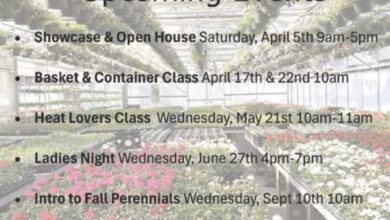Ashland Greenhouses – Spring Fever
Spring Fever
by Kelly Brainard Owner of Ashland Greenhouses
Every April we offer classes on creating containers and hanging baskets and they are always our most popular. A list of classes is available on our website. Since the classes fill up so quickly I wanted to share with you some of the key concepts we go over in the classes just in case you aren’t able to attend.
First it’s most important to consider the roots of the plants. Stop thinking about the top of the plant and how it looks, but consider the root system and make sure you’re providing good soil and ample space for the roots to grow and be happy all season. Start off with making sure that you have good, fresh potting soil. Potting soil is much better than any other soil because it is incredibly lightweight and allows for good drainage. Other soils are better suited for flowerbeds and do not provide enough drainage for containers and will compact over time which then makes for unhappy roots. Next you’ll want to make sure you do not overplant your container. It’s difficult because we all want the instant “wow factor” and cram in as much as possible to make the container look full. All you’ve done is crowd in a bunch of plants that will soon be competing for space, water and fertilizer. As the summer goes on containers that have been overplanted start to look stressed-out and need constant watering. Analyze your container and think about how much soil it will hold. That will help you determine how many plants you should use. A good guide is our 10”-12” baskets. We only put 4-5 plants in them.
When choosing plants consider the location and lighting where you’ll be placing your containers. Remember, areas that only get afternoon sun typically need plants that can tolerate “full sun”. Plants requiring “partial sun” do not perform well in our area when they have morning shade and afternoon sun. They do best when protected from afternoon sun.
Once you’ve planted your containers and baskets the best advice I can give is to make sure and fertilizer them once a week with an all-purpose liquid fertilizer. Nutrients are leached out of the containers quickly with each watering, so it is important to feed them often. You’ll see a huge improvement with your containers if you fertilizer once a week.




